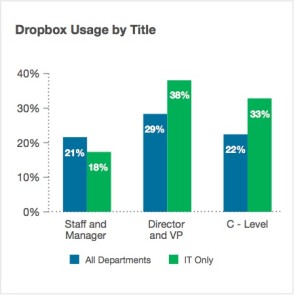A recent article written by Barb Darrow of GigaOm points to research by Nasuni, an enterprise storage management company, that found that a fifth of 1,300 business users surveyed said they use Dropbox to store and share business documents. Half of which don’t know it’s against the rules.
Furthermore, the study found that users who use Dropbox most frequently for business purposes are senior employees at the vice president and director level, followed closely by C-level employees.
As someone guilty of occasionally working from a Dropbox account that’s not sanctioned by my company, this statistic doesn’t surprise me. Senior and C-level workers are mobile, more frequently working offsite from a coffee shop after a business meeting or late into the night from home. These are also the people who first introduced iPads and other personal devices into the office and wanted to integrate them within their corporate environments.
It also doesn’t surprise me that the graph indicates that IT professionals are most guilty of this practice—we are the ones who intimately know about all the hosted file sharing options and technologies like Dropbox.
IT professionals are also the employees who should know better. We’ve talked on the blog before about the risks associated with using a hosted file sharing service in the office. Specifically, you quickly run into security and data-management issues when using a hosted service, i.e., an employee leaves your company and takes any local copies of company files that live on that employee’s personal laptop and/or home computer with him or her.
As a business owner, you need to be at least aware of these risks and make sure your employees understand the rules and policies that you have in place to protect sensitive company documents. Explain why you these rules exist, and how they help protect the employee and health of the company as a whole.
If you have questions about file sharing within your business, check out our best practices here.
